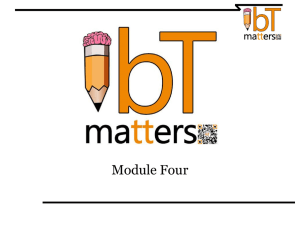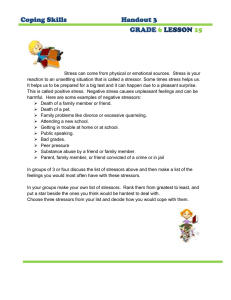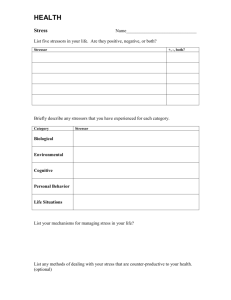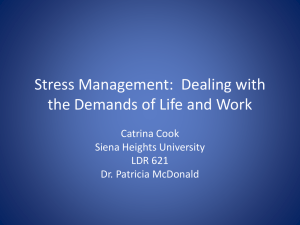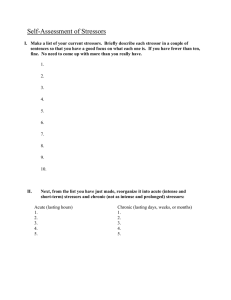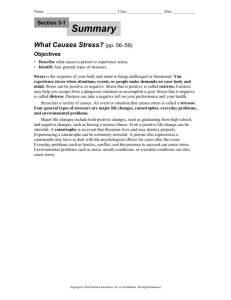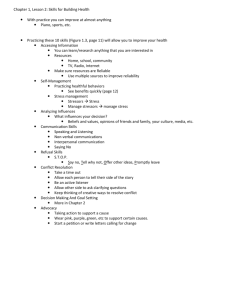Stress Management
advertisement
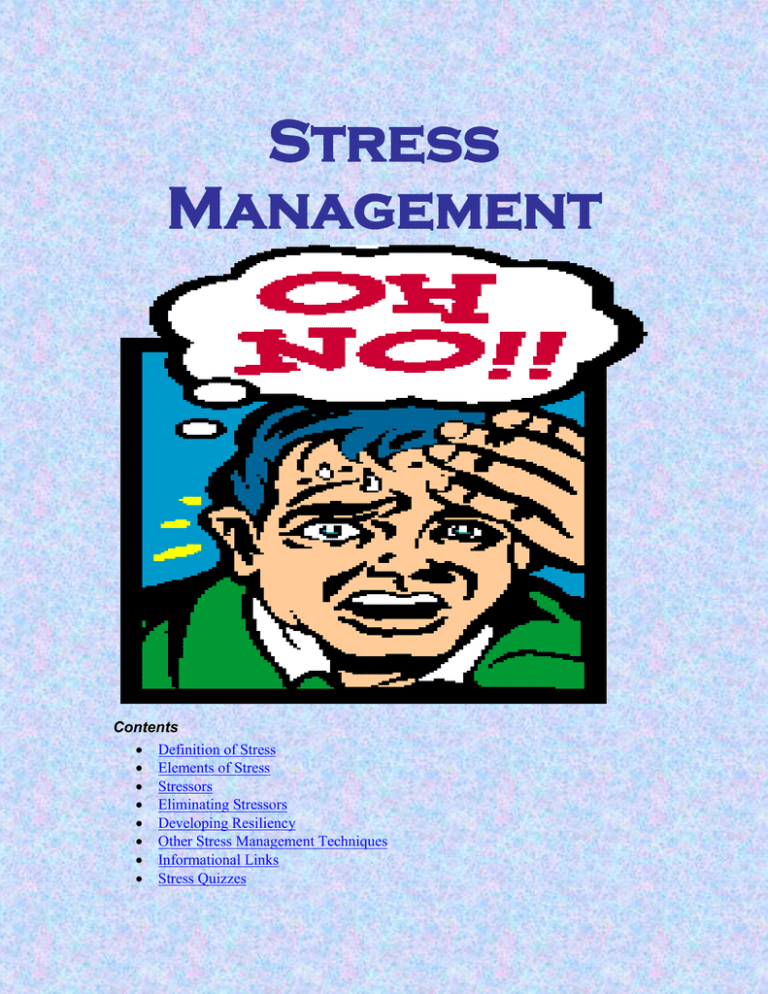
Stress Management Contents Definition of Stress Elements of Stress Stressors Eliminating Stressors Developing Resiliency Other Stress Management Techniques Informational Links Stress Quizzes Credits and Stress Pics Funny stress Pictures and helpful hints from us for relieving stress. Stress: A mentally or emotionally disruptive or upsetting condition occurring in response to adverse external influences and capable of affecting physical health, usually characterized by increased heart rate, a rise in blood pressure, muscular tension, irritability, and depression. Back to top Elements of Stress We need to think of stress as the product of a “force field” in order to understand its dynamics. Kurt Lewin suggested that all individuals and organizations exist in an environment filled with reinforcing or opposing forces (i.e. stresses). These forces act to stimulate or inhibit the performance desired by the individual. According to Lewin’s theory, the forces affecting individuals are normally balanced in the force field. The strength of the driving forces is exactly matched by the strength of the restraining forces. Performance changes when these forces become imbalanced. In other words, if the driving forces become stronger than the restraining forces, change occurs. On the contrary, if restraining forces become stronger than driving forces, change occurs in the opposite direction. The feelings of stress are a product of certain stressors inside or outside the individual. These stressors can be thought of as driving forces in the model. That is, they exert pressure on the individual to change present levels of performance physiologically, psychologically and interpersonally. However, most people have developed a certain amount of resiliency or restraining forces to counter stressors. Strong restraining forces can lead to low heart rates, good interpersonal relationships, emotional stability, and effective stress management. Reactions to Stress Before reaching an extreme state of stress, individuals typically progress through three stages of reactions: an alarm stage, a resistance stage, and an exhaustion stage. a.) Alarm stage- characterized by acute increases in anxiety or fear if the stressor is a threat or by increases in sorrow or depression if the stressor is a loss. Physiologically, the individual’s energy resources are mobilized and hear rate, blood pressure, and alertness increase. If these reactions persist, the individual enters into the resistance stage. b.) Resistance stage- defense mechanism predominates in this stage and the body begins to store up excess energy. There are five types of defense mechanisms that are typical of most people who experience extended levels of stress. 1.) Aggression- involves attacking the stressor directly (either attacking oneself, other people, or even objects). 2.) Regression- adoption of a behavior pattern or response that was successful at some earlier time (e.g. responding in childish ways). 3.) Repression- involves denial of the stressor, forgetting, or redefining the stressor (e.g. deciding that it isn’t so scary after all). 4.) Withdrawal- takes both psychological and physical forms. Individuals may engage in fantasy, inattention or escape from the situation itself. 5.) Fixation- persisting in a response regardless of its effectiveness (e.g. repeatedly and rapidly redialing a phone number when it is busy). c.) Exhaustion Stage- this is the most dangerous stage. When stress is so pronounced as to overwhelm defenses or so enduring as to outlast available energy for defensiveness, exhaustion may result, producing pathological consequences. Such pathological consequences may be manifest physiologically (e.g. heart disease), psychologically (e.g. severe depression) or interpersonally (e.g. dissolution of relationships). Coping with Stress In managing stress there is a particular hierarchy of strategies that individuals can utilize that have been found effective: a.) Enactive strategies- the best way to manage stress is to minimize or eliminate stressors. These create, or enact, a new environment for the individual that does not contain the stressors. b.) Proactive strategies- individuals enhance their overall capacity to handle stress by increasing their personal resiliency. c.) Reactive strategies- individuals develop short-term techniques for coping with stressors. These are on-the-spot remedies to reduce temporarily the effects of stress. Back to top Stressors There are four major types of stressors: Time stressors are mostly associated with having too much work to do in too little an amount of time. This stressor is said to be a result of our culture’s attention to time – our society is very time conscience. If time stressors are experienced on a daily basis, the effect can be very dangerous. Temporary time stressors may serve to motivate some in getting work done, but overall, they can be harmful if experienced to often. Encounter stressors are associated with interpersonal interactions. They generally arise from conflicts. There are three main types of conflicts: role conflicts occur when the roles of group members are incompatible; issue conflicts occur when there are disagreements on how to define or solve a problem; and interaction conflicts occur when individuals do not get along for whatever reason. Poor relationships with people can cause high levels of stress. Situational stressors arise from one’s environment and circumstances that occur. A common form of situation stress is working in unfavorable conditions. Also, rapid changes and changes of life are main factors that cause stress. Anticipatory stressors occur when potential problems exist. This is the fear of unpleasant things happening, although they have not happened yet. The unpleasant situation that is feared does not need to be severe, it just needs to exist. A common anticipatory stressor is the fear of failure or embarrassment in front of peers. Here is a summary of the types of stressors: TIME STRESSORS Work overload Lack of control ENCOUNTER STRESSORS Role conflicts Issue conflicts Action conflicts SITUATIONAL STRESSORS Unfavorable working conditions Rapid change ANTICIPATORY STRESSORS Unpleasant expectations Fear Back to top Eliminating Stressors Individuals can actively work to create more favorable environmental circumstances in which to work and live: “enact” the environment rather than merely “react” Ways to eliminate each of the four types of stressors TYPE OF STRESSOR Time ELIMINATION STRATEGY Effective time management Efficient time management Delegating Encounter Collaboration and clan building Interpersonal competence Situational Work redesign Anticipatory Goal setting Small wins Eliminating Time Stressors Through Time Management Two different sets of skills are important for effectively managing time and for eliminating stress: I. Focuses on effectively using time over the long term (1) individuals spend their time on important matters, not just urgent matters (2) people are able to distinguish clearly between what they view as important versus what they view as urgent (3) results rather than methods are the focus of time management strategies (4) people have a reason not to feel guilty when they must say no In order to manage your time effectively, “don’t allow others to determine what is and is not important for you.” Make certain that you focus on activities that are important, not just urgent. Identify clear and specific personal priorities. In order to help you articulate clearly the basis for judging the importance of activities, ask yourself the following questions: What do I stand for? What am I willing to die (or live) for? What do I care passionately about? What legacy would I like to leave? What do I want to be remembered for? If I could persuade everyone in the world to follow a few basic principles, what would they be? What do I want to have accomplished 20 years form now? II. Efficient Time Management Accomplishing more during the day by not wasting time. Time management techniques for everyone in daily life: (1) Read selectively (2) Make a list of things to perform today (3) Have a place for everything and keep everything in its place (4) Prioritize your tasks (5) Do one important thing at a time but several trivial things simultaneously (6) Make a list of some 5- or 10-minute discretionary tasks (7) Divide up large projects (8) Determine the critical 20 percent of your tasks (9) Save your best time for important matters (10) Reserve some time during the day when others don’t have access to you (11) Don’t procrastinate (12) Keep track of time use (13) Set deadlines (14) Do something productive while waiting (15) Do busy work at one set time during the (16) Reach closure on at least one thing every (17) Schedule some personal time (18) Don’t worry about anything continually (19) Have long-term objectives (20) Be on the alert for ways to improve your management of time Eliminating Anticipatory Stressors: Stress associated with anticipating an event is more a product of psychological anxiety than current work circumstances. To eliminate that source of stress requires a change in the thought processes, priorities and plans. (1) Prioritizing Establishing clear personal priorities, such as identifying what is to be accomplished in the long term, what cannot be compromised or sacrificed, and what lasting legacy do you desire. (2) Goal Setting Establishing short-term plans (see model) (3) Small Wins Rules for instituting small wins: identify something that is under your control change it in a way that leads toward your desired goal find some other small thing to change and change it keep track of the changes you are making maintain the small gains you have made A Model for Short-Term Planning and Goal Setting 1 Establish a goal 4 Identify criteria of success and a reward 2 Specify action and behavioral requirements 3 Generate accountability and mechanisms Back to top Developing Resiliency Resiliency is associated with balancing the various aspects of one’s life. Those individuals who are best able to cope with stress in their life can achieve life balance and reach the highest level of resiliency. However, it is important that you develop many ways to deal with your stress so that you become a well-rounded individual. Only developing activity that allows you to deal with your stress can be counterproductive. It is important to develop many other activities. When you’re having trouble at work it is often a response to work extra hard to solve the problem. This can restrict your creative flow and often the solution to a problem can be found using analogies from unrelated activities. You also want to have a refreshed and relaxed mind so that you are able to think clearly. Stress-related illness decreases and can save both you and your company money from having to deal with these illnesses. Physiological Resiliency Cardiovascular conditioning and dietary control are the two major components that make up physical resiliency. Studies have shown overwhelmingly that those who are in good physical condition are better able to cope with stressors than those in poor physical condition. Three primary purposes for regular exercise programs are: maintaining optimal weight, increasing psychological well-being, and improving the cardiovascular system. The resulting excessive strain on the body that comes from being overweight makes those individuals more vulnerable to stress. Advantages to regular exercise helps are an improved mental as well as physical outlook and strengthened cardiovascular system. An improved diet can help reduce your level of stress by making your body healthier and helping give you energy to get through your day. Here are “Ten Steps to Good Nutrition” that we can all benefit from: Eat a variety of foods Maintain optimal weight Avoid fats Eat more whole foods Avoid sugar Avoid sodium Avoid alcohol Avoid caffeine Take vitamin and mineral supplements Make eating relaxing time Psychological Resiliency There are many factors that help us deal with stress, but there are certain characteristics we all possess, called “personality types”, that allow some people to cope better with stress than others. Two specific personality types are the hardy and the Type A personality. A Hardy has three elements that make them highly stress-resistant. These are: 1. Feeling in control of one’s life, rather than powerless to shape external events. 2. Feeling committed to and involved in what one is doing, rather than alienated from one’s work and other individuals. 3. Feeling challenged by new experiences rather than viewing change as a threat to security and comfort. Hardy individuals tend to interpret stressful situations positively and optimistically, and they respond to stress constructively. As a result, their incidence of illness and emotional dysfunction under stressful conditions is considerably below the norm. A Type A personality is developed by many people who are entering the competitive worlds of advanced education and of management. Anxiety, deteriorating relationships, and heart disease have all been discovered to have a greater likelihood of occurring in a person with a Type A personality. Some characteristics of Type A personalities are: 1. 2. 3. 4. 5. 6. 7. 8. 9. Extreme competitiveness Strong desires for achievement Haste Impatience Restlessness Hyper-alertness Explosiveness of speech Tenseness of facial muscles Free-floating hostility Two ways of coping with these characteristics that increase your stress include The Small-Wins Strategy and Deep-Relaxation Strategies. In the Small-Wins approach, individuals work for small wins, they consciously remain sensitive to their small successes, and celebrate them, while coping with major stressors. When individuals work for a small, concrete outcome, giving them a chance to enjoy visible success, heightened confidence, excitement, and optimism result, which motivate an attempt to accomplish another small win. The Deep-Relaxation Strategy include meditation, yoga, autogenic training or self-hypnosis, and biofeedback. Considerable evidence exists that individuals who practice such techniques regularly are able to condition their bodies to inhibit the negative effects of stress. When stress occurs, many who use these techniques find that they don’t get as high strung, and it is easier for them to come back down. Most deep-relaxation techniques require the following conditions: 1. A quiet environment 2. A comfortable position 3. A mental focus 4. 5. 6. 7. Controlled breathing A passive attitude Focused bodily changes Repetition Most of the techniques used for deep-relaxation must be practiced over a period of time to develop fully, but they are not difficult to learn. Social Resiliency Individuals who are embedded in supportive social networks are less likely to experience stress and are better equipped to cope with its consequences. Supportive social relations provide opportunities to share one’s frustrations and disappointments, to receive suggestions and encouragement, and to experience emotional bonding. Such supportive interactions provide the empathy and bolstering required to cope with stressful events. They are formed most easily among individuals who share close emotional ties or common experiences. Family and friends are among the best sources that this support may come from. However, a manager who can help foster a good working relationship can also be a great system of support. Many companies have begun sponsoring a “Mentor” program where an experienced, and higher level employee, can guide the career of a lesser-experienced employee. Work groups and teams also help with the coping of stress by creating teams or groups where the people share in the same experiences and can share with one another their frustrations if necessary. Back to top Other Stress Management Techniques Activities for Managing Stress (Source: Whetten, David A. and Cameron, Kim S., Developing Management Skills, p.133-34) 1. Do a systematic analysis of the stressors you face in your job, family, school, and social life. List the types of stressors you face, and identify strategies to eliminate or sharply reduce them. Record this analysis in a journal. 2. Find someone you know well who is experiencing a great deal of stress. Teach him or her how to manage that stress better by applying the concepts, principles, techniques, and exercises suggested in this website. Describe what you taught and record the results in a journal. 3. Implement at least three of the time management techniques suggested in this website. Keep track of the amount of time these techniques save you over a onemonth period. Be sure to use that extra time productively. 4. With a coworker or colleague, identify ways in which your work at school, job, or home can be redesigned to reduce stress and increase productivity. Use some of the suggestions provided in this website. 5. Write a personal principles statement. Specify precisely your core principles; those things you consider to be central to your life and your sense of self-worth; and the legacy you want to leave. Identify at least one thing that you want to accomplish in your life that you would like to be known for. Begin working on it today. 6. Establish a short-term goal or plan that you wish to accomplish this year. Make it compatible with the top priorities in your life and share this plan with others you know so that you have an incentive to pursue it more. 7. Get a physical examination, then outline and implement a regular physical fitness and diet program. Even if it is just regular walking, do some kind of physical exercise at least three times a week. Preferably, institute a regular, vigorous cardiovascular fitness program. Record your progress in a journal. 8. Pick at least one long-term deep-relaxation technique. Learn it and practice it on a regular basis. Record your progress in a journal. 9. Establish a mentoring relationship with someone with whom you work or go to school. Your mentor may be a professor, a senior manager, or someone who has been around longer than you have. Make certain that the relationship is reciprocal and that it will help you cope with the stresses you face at work or school. Temporary Stress Reduction Techniques 1. Muscle relaxation- involves easing the tension in successive muscle groups. Start with the feet and progress to the calves, thighs, stomach, and on to the neck and face, one can relieve tension throughout the entire body. All parts of the body can be included in the exercise. Alternatively, you can roll your head around on the neck several times, shrug the shoulders, or stretch the arms up toward the ceiling for five to ten seconds, then release the position and relax the muscles. 2. Deep breathing- you should take several successive, slow, deep-breaths, holding them for five seconds, and exhaling completely. You should focus on breathing itself, so that the mind becomes cleared for a brief time while the body relaxes. After each deep breath, muscles in the body should consciously be relaxed. 3. Imagery and fantasy- imagery involves visualizing an event, using “mind pictures”. It can also include recollections of sounds, smells, and textures. The mind focuses on pleasant experiences from the past (e.g. family vacation, day at the beach, etc) that can be recalled vividly. On the contrary, fantasies are not past memories but make-believe events or images. The purpose of this technique is to relieve anxiety or pressure temporarily by focusing on something pleasant so that other, more productive stress-reducing strategies can be developed for the longer term. 4. Rehearsal- appropriate reactions are rehearsed, either in a safe environment before stress occurs. Removing oneself temporarily from stressful situation and working through dialogue or reactions, as though rehearsing for a play, can help one regain control and reduce the immediacy of the stressor. 5. Reframing- involves temporarily reducing stress by optimistically redefining a situation as manageable. Although reframing is difficult in the midst of a stressful situation, it can be facilitated by using some of the following cues: “I understand this situation.” “Other people are available to help me get through this situation.” “I can learn something from this situation.” “There are several good alternatives available to me.” Each of these statements can help an individual to reframe a situation in order to develop long-term proactive or enactive strategies. Back to top Informational Links The International Stress Management Association UK is a registered charity with a multi-disciplinary professional membership. It exists to promote sound knowledge and best practice in the prevention and reduction of human stress. It sets professional standards for the benefit of individuals and organizations using the services of its members. www.isma.org.uk Learn a chant for meditation, home.earthlink.net/~dmswanson/om.html Stress Management Consulting, www.stress-management.com Physical Fitness and Stress Management, www.secondwind.net How to Master Stress, www.psychwww.com/mtsite/smpage.html How to Survive Unbearable Stress, www.teachhealth.com OMMM! A Review of Principles, www.unl.edu/stress/mgmt/ Stress Busters, www.stressrelease.com/strssbus.html Stress Free Net, www.stressfree.com Back to top Stress Quizzes Here is a chance for you to quiz yourself and find out how stressed you are. You can also compare your scores to the average. How tense are you? Stress Inventory Survey Stress Assess Back to top
